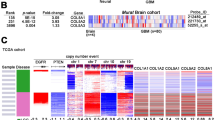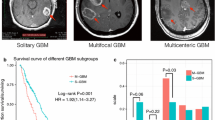Abstract
Medulloblastoma is the most common malignant brain tumor of children, and more specific and effective therapeutic management needs to be developed to improve upon existing survival rates and to avoid side-effects from current treatment. Gain of chromosome seven is the most frequent chromosome copy number aberration in medulloblastoma, suggesting that overexpression of genes on chromosome seven might be important for the pathogenesis of medulloblastoma. We used microarrays to identify chromosome seven genes overexpressed in medulloblastoma specimens, and validated using data from published gene expression datasets. The gene encoding the alpha 2 subunit of type I collagen, COL1A2, was overexpressed in all three datasets. Immunohistochemistry of tumor tissues revealed type I collagen in the leptomeninges, and in the extracellular matrix surrounding blood vessels and medulloblastoma cells. Expression of both type I collagen and the β1 subunit of integrin, a subunit of a known type I collagen receptor, localized to the same area of medulloblastoma. Adherence of D283 medulloblastoma cells to type I collagen matrix in vitro depends on the β1 subunit of integrin. Because medulloblastoma is characteristic of high vascularity, and because inhibition of type I collagen synthesis has been shown to suppress angiogenesis and tumor growth, our data suggest that type I collagen might be a potential therapeutic target for treating medulloblastoma.




Similar content being viewed by others
References
Jemal A, Murray T, Samuels A (2003) Cancer Statistics. CA Cancer J Clin 53:5–26
Rutkowski S (2006) Current treatment approaches to early childhood medulloblastoma. Expert Rev Neurother 6(8):1211–1221
Evans AE, Jenkin RD, Sposto R et al (1990) The treatment of medulloblastoma. Results of a prospective randomized trial of radiation therapy with and without CCNU, vincristine, and prednisone. J Neurosurg 72(4):572–582
Packer RJ, Sutton LN, Elterman R et al (1994) Outcome for children with medulloblastoma treated with radiation and cisplatin, CCNU, and vincristine chemotherapy. J Neurosurg 81(5):690–698
Zeltzer PM, Boyett JM, Finlay JL et al (1999) Metastasis stage, adjuvant treatment, and residual tumor are prognostic factors for medulloblastoma in children: conclusions from the Children’s Cancer Group 921 randomized phase III study. J Clin Oncol 17(3):832–845
Marino S (2005) Medulloblastoma: developmental mechanisms out of control. Trends Mol Med 11(1):17–22
MacDonald TJ, Brown KM, LaFleur B et al (2001) Expression profiling of medulloblastoma: PDGFRA and the RAS/MAPK pathway as therapeutic targets for metastatic disease. Nat Genet 29(2):143–152
Dirks PB, Harris L, Hoffman HJ et al (1996) Supratentorial primitive neuroectodermal tumors in children. J Neurooncol 29(1):75–84
Albright AL, Wisoff JH, Zeltzer P et al (1995) Prognostic factors in children with supratentorial (nonpineal) primitive neuroectodermal tumors. A neurosurgical perspective from the Children’s Cancer Group. Pediatr Neurosurg 22(1):1–7
Cohen BH, Zeltzer PM, Boyett JM et al (1995) Prognostic factors and treatment results for supratentorial primitive neuroectodermal tumors in children using radiation and chemotherapy: a Childrens Cancer Group randomized trial. J Clin Oncol 13(7):1687–1696
Huber H, Eggert A, Janss AJ et al (2001) Angiogenic profile of childhood primitive neuroectodermal brain tumours/medulloblastomas. Eur J Cancer 37(16):2064–2072
Grotzer MA, Wiewrodt R, Janss AJ et al (2001) High microvessel density in primitive neuroectodermal brain tumors of childhood. Neuropediatrics 32(2):75–79
Pomeroy SL, Tamayo P, Gaasenbeek M et al (2002) Prediction of central nervous system embryonal tumour outcome based on gene expression. Nature 415(6870):436–442
Russo C, Pellarin M, Tingby O et al (1999) Comparative genomic hybridization in patients with supratentorial and infratentorial primitive neuroectodermal tumors. Cancer 86(2):331–339
Burnett ME, White EC, Sih S, von Haken MS, Cogen PH (1997) Chromosome arm 17p deletion analysis reveals molecular genetic heterogeneity in supratentorial and infratentorial primitive neuroectodermal tumors of the central nervous system. Cancer Genet Cytogenet 97(1):25–31
McCabe MG, Ichimura K, Liu L et al (2006) High-resolution array-based comparative genomic hybridization of medulloblastomas and supratentorial primitive neuroectodermal tumors. J Neuropathol Exp Neurol 65(6):549–561
Bayani J, Zielenska M, Marrano P et al (2000) Molecular cytogenetic analysis of medulloblastomas and supratentorial primitive neuroectodermal tumors by using conventional banding, comparative genomic hybridization, and spectral karyotyping. J Neurosurg 93(3):437–448
Reardon DA, Michalkiewicz E, Boyett JM et al (1997) Extensive genomic abnormalities in childhood medulloblastoma by comparative genomic hybridization. Cancer Res 57(18):4042–4047
Ramaswamy S, Tamayo P, Rifkin R et al (2001) Multiclass cancer diagnosis using tumor gene expression signatures. Proc Natl Acad Sci U S A 98(26):15149–15154
Boon K, Osorio EC, Greenhut SF et al (2002) An anatomy of normal and malignant gene expression. Proc Natl Acad Sci U S A 99(17):11287–11292
Velculescu VE, Zhang L, Vogelstein B, Kinzler KW (1995) Serial analysis of gene expression. Science 270(5235):484–487
Karsenty G, Park RW (1995) Regulation of type I collagen genes expression. Int Rev Immunol 12(2–4):177–185
Karsenty G, de Crombrugghe B (1991) Conservation of binding sites for regulatory factors in the coordinately expressed alpha 1 (I) and alpha 2 (I) collagen promoters. Biochem Biophys Res Commun 177(1):538–544
Werb Z, Tremble PM, Behrendtsen O, Crowley E, Damsky CH (1989) Signal transduction through the fibronectin receptor induces collagenase and stromelysin gene expression. J Cell Biol 109(2):877–889
Wayner EA, Gil SG, Murphy GF, Wilke MS, Carter WG (1993) Epiligrin, a component of epithelial basement membranes, is an adhesive ligand for alpha 3 beta 1 positive T lymphocytes. J Cell Biol 121(5):1141–1152
Quackenbush J (2006) Microarray analysis and tumor classification. N Engl J Med 354(23):2463–2472
Liang Y, Diehn M, Watson N et al (2005) Gene expression profiling reveals clinically distinct subtypes of glioblastoma multiforme. Proc Natl Acad Sci U S A 102(16):5814–5819
Liang Y, Bollen AW, Nicholas MK, Gupta N (2005) Id4 and FABP7 are preferentially expressed in cells with astrocytic features in oligodendrogliomas and oligoastrocytomas. BMC Clin Pathol 5:6
Liang Y, Bollen AW, Aldape KD, Gupta N (2006) Nuclear FABP7 immunoreactivity is preferentially expressed in infiltrative glioma and is associated with poor prognosis in EGFR-overexpressing glioblastoma. BMC Cancer 6:97
Montesano R, Orci L, Vassalli P (1983) In vitro rapid organization of endothelial cells into capillary-like networks is promoted by collagen matrices. J Cell Biol 97(5 Pt 1):1648–1652
Jackson CJ, Jenkins KL (1991) Type I collagen fibrils promote rapid vascular tube formation upon contact with the apical side of cultured endothelium. Exp Cell Res 192(1):319–323
Elkin M, Miao HQ, Nagler A et al (2000) Halofuginone: a potent inhibitor of critical steps in angiogenesis progression. Faseb J 14(15):2477–2485
Abramovitch R, Dafni H, Neeman M, Nagler A, Pines M (1999) Inhibition of neovascularization and tumor growth, and facilitation of wound repair, by halofuginone, an inhibitor of collagen type I synthesis. Neoplasia 1(4):321–329
Elkin M, Ariel I, Miao HQ et al (1999) Inhibition of bladder carcinoma angiogenesis, stromal support, and tumor growth by halofuginone. Cancer Res 59(16):4111–4118
Gross DJ, Reibstein I, Weiss L et al (2003) Treatment with halofuginone results in marked growth inhibition of a von Hippel-Lindau pheochromocytoma in vivo. Clin Cancer Res 9(10 Pt 1):3788–3793
White DJ, Puranen S, Johnson MS, Heino J (2004) The collagen receptor subfamily of the integrins. Int J Biochem Cell Biol 36(8):1405–1410
Gamble JR, Matthias LJ, Meyer G et al (1993) Regulation of in vitro capillary tube formation by anti-integrin antibodies. J Cell Biol 121(4):931–943
Guo W, Giancotti FG (2004) Integrin signalling during tumour progression. Nat Rev Mol Cell Biol 5(10):816–826
Hannigan GE, Leung-Hagesteijn C, Fitz-Gibbon L et al (1996) Regulation of cell adhesion and anchorage-dependent growth by a new beta 1-integrin-linked protein kinase. Nature 379(6560):91–96
Wu C, Dedhar S (2001) Integrin-linked kinase (ILK) and its interactors: a new paradigm for the coupling of extracellular matrix to actin cytoskeleton and signaling complexes. J Cell Biol 155(4):505–510
MacDonald TJ, Taga T, Shimada H et al (2001) Preferential susceptibility of brain tumors to the antiangiogenic effects of an alpha(v) integrin antagonist. Neurosurgery 48(1):151–157
Taga T, Suzuki A, Gonzalez-Gomez I et al (2002) alpha v-Integrin antagonist EMD 121974 induces apoptosis in brain tumor cells growing on vitronectin and tenascin. Int J Cancer 98(5):690–697
Rutka JT, Giblin J, Dougherty DV et al (1986) An ultrastructural and immunocytochemical analysis of leptomeningeal and meningioma cultures. J Neuropathol Exp Neurol 45(3):285–303
Rutka JT (1997) Medulloblastoma. Clin Neurosurg 44:571–585
Ozer E, Sarialioglu F, Cetingoz R et al (2004) Prognostic significance of anaplasia and angiogenesis in childhood medulloblastoma: a pediatric oncology group study. Pathol Res Pract 200(7–8):501–509
Chung DH, Lee JI, Kook MC et al (1998) ILK (beta1-integrin-linked protein kinase): a novel immunohistochemical marker for Ewing’s sarcoma and primitive neuroectodermal tumour. Virchows Arch 433(2):113–117
Acknowledgements
We thank the Brain Tumor Research Center Tissue Bank of UCSF for contributing tissue specimens in this study. This work was supported by funding from the Department of Neurological Surgery at UCSF, and by National Institute of General Medical Sciences training grant GM07365 (M.D.), and the Theodora B. Betz Foundation and Kyra Memorial Fund (M.A.I.). UCSF is an NCI-designated Specialized Program of Research Excellence for Brain Tumors.
Author information
Authors and Affiliations
Corresponding author
Electronic supplementary material
Below is the link to the electronic supplementary material
Rights and permissions
About this article
Cite this article
Liang, Y., Diehn, M., Bollen, A.W. et al. Type I collagen is overexpressed in medulloblastoma as a component of tumor microenvironment. J Neurooncol 86, 133–141 (2008). https://doi.org/10.1007/s11060-007-9457-5
Received:
Accepted:
Published:
Issue Date:
DOI: https://doi.org/10.1007/s11060-007-9457-5




